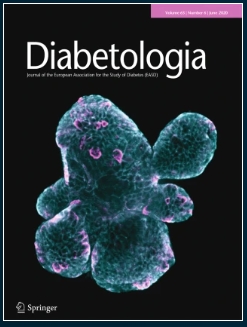Restoration of pancreatic beta cell identity and autophagy in KATP-induced diabetes by intermittent fasting.
IF 10.2
1区 医学
Q1 ENDOCRINOLOGY & METABOLISM
引用次数: 0
Abstract
AIMS/HYPOTHESIS The loss of pancreatic beta cell mass and identity is a hallmark of diabetes. While factors such as beta cell overwork (insulin hypersecretion) and elevated intracellular calcium have been implicated, beta cell identity loss also occurs in KATP gain-of-function (KATP-GOF) mice, a model of human neonatal diabetes, even in the absence of these factors. This suggests additional underlying mechanisms. Autophagy, a key process for cellular homeostasis, is impaired in the islets and beta cells of both type 1 and type 2 diabetes, but its role in monogenic diabetes with insulin secretory deficiency remains unclear. We hypothesise that autophagy dysfunction contributes to beta cell identity loss in KATP-GOF mice, and that intermittent fasting (IF) can restore autophagic flux, thereby preserving functional beta cell mass. METHODS To test this, adult tamoxifen-inducible KATP-GOF mice and littermate controls were randomly assigned to two groups: (1) chow diet ad libitum; and (2) chow diet with alternate-day IF. RESULTS KATP-GOF mice fed ad libitum developed severe hyperglycaemia due to impaired insulin secretion. This was followed by a reduction in insulin content, disruption of beta cell autophagic flux, autophagosome accumulation and, ultimately, the loss of beta cell identity and dedifferentiation. In contrast, KATP-GOF mice subjected to alternate-day IF exhibited lower blood glucose levels, improved mitochondrial morphology, restoration of autophagic flux and reestablishment of beta cell identity. CONCLUSIONS/INTERPRETATION This study provides the first evidence of autophagy impairment in non-obese, insulin secretory-deficient, KATP-induced diabetes mice and demonstrates that IF restores both autophagic flux and beta cell identity. This finding suggests that similar mechanisms may contribute to beta cell dysfunction in other forms of diabetes.间歇性禁食对katp诱导糖尿病胰腺β细胞特性和自噬的恢复作用。
目的/假设胰腺β细胞质量和特性的丧失是糖尿病的一个标志。虽然β细胞过度工作(胰岛素分泌过多)和细胞内钙升高等因素与此有关,但即使在没有这些因素的情况下,β细胞身份丧失也会发生在KATP功能获得(KATP- gof)小鼠(人类新生儿糖尿病模型)中。这表明还有其他潜在机制。自噬是细胞稳态的一个关键过程,在1型和2型糖尿病的胰岛和β细胞中受损,但其在胰岛素分泌不足的单基因糖尿病中的作用尚不清楚。我们假设自噬功能障碍导致了KATP-GOF小鼠的β细胞身份丧失,而间歇性禁食(IF)可以恢复自噬通量,从而保持功能性β细胞质量。方法将他莫昔芬诱导的KATP-GOF成年小鼠和同窝对照随机分为两组:(1)随意饲喂;(2)隔日IF喂养。结果随意喂养的skatp - gof小鼠由于胰岛素分泌受损而出现严重的高血糖。随后是胰岛素含量降低、β细胞自噬通量中断、自噬体积累,最终导致β细胞身份丧失和去分化。相比之下,隔日IF处理的KATP-GOF小鼠血糖水平降低,线粒体形态改善,自噬通量恢复,β细胞身份重建。结论/解释:本研究首次提供了非肥胖、胰岛素分泌不足、katp诱导的糖尿病小鼠自噬损伤的证据,并证明IF可以恢复自噬通量和β细胞特性。这一发现表明,在其他形式的糖尿病中,类似的机制可能导致β细胞功能障碍。
本文章由计算机程序翻译,如有差异,请以英文原文为准。
求助全文
约1分钟内获得全文
求助全文
来源期刊

Diabetologia
医学-内分泌学与代谢
CiteScore
18.10
自引率
2.40%
发文量
193
审稿时长
1 months
期刊介绍:
Diabetologia, the authoritative journal dedicated to diabetes research, holds high visibility through society membership, libraries, and social media. As the official journal of the European Association for the Study of Diabetes, it is ranked in the top quartile of the 2019 JCR Impact Factors in the Endocrinology & Metabolism category. The journal boasts dedicated and expert editorial teams committed to supporting authors throughout the peer review process.
 求助内容:
求助内容: 应助结果提醒方式:
应助结果提醒方式:


